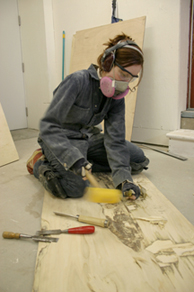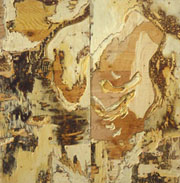Disclosure:
Revealing the Layers of Yechel Gagnon’s Work
Virginia MacDonnell Eichhorn
To describe Yechel Gagnon’s work as layered, is to give it the most simple yet also the most comprehensive of descriptions. For Yechel, layering is what it’s all about. It describes her process, her style, her content and her themes. If we were to extend our description of her work, we would also need to include elegant, sophisticated, masterful, complex and beautiful. And even then, we’ve only begun to scratch the surface of understanding all the facets of her artmaking.
I’ve had the pleasure and privilege of knowing Yechel for several years now. I first met her when she was a second-year student at the Ontario College of Art and Design (OCAD.) In that time, I have seen her dedication and commitment to creating the best work she possibly could. She has been relentless in pursing her particular artistic idiom and in finding and developing her stylistic oeuvre.
Her chosen medium over these several years has been wood – particularly plywood. Her process has allowed her to fully explore and extend all the possibilities inherent within that medium. She has created it, subverted it, reclaimed it and even turned it inside out. And each step of development has given us something fresh and previously unseen. For such a young artist, not quite thirty years of age, Yechel intuits when a work is “complete”. Despite the incredibly intensive hands-on process of routering, carving and digging into the wood – the finished appearances of her pieces are never over-worked. This is a skill which a number of senior artists still have yet to master.
Of course, when one thinks of plywood in the context of Canadian art, invariably the first name that comes to mind is Patterson Ewen. However, Yechel’s work is no more similar to his than a Van Gogh is to a Coleville. The medium is the same, however the approach, the eye, the vision – of both artists – is separate, unique and distinct.
It was at OCAD that Yechel first began creating works in plywood. She began working with plywood by applying paint directly to carved surfaces. This led to her creating her own plywood by layering together different wood, paper, veneer and fabric. Eventually she stopped creating this “exotic” plywood and began using utilitarian contractor’s plywood as her source material. For several years now she has been exploring the materiality of this medium in her work.
Her original plywood creations might best be characterized as assemblages. These works consisted – in Yechel’s words – of “sexy woods” such as mahogany being layered together with other pieces of wood and canvas. These layers were then glued together. After they were dry, Yechel would then carve into them, thereby revealing what the underlying structure was. She would sometimes paint these works as well thereby adding another dimension to them. Her intention in this methodology was to create a dialogue between the diverse layers of the purposely-distressed wood. Her chisel, blowtorch and electric router became in effect her drawing and painting tools. This technique was characterized as an “excavation”.
The technique that Yechel used became a metaphor for the issues which she addressed in her early work. Primarily, she was concerned with creating work that addressed the deterioration of nature and the devastating effects that our industrialized contemporary society has had on our natural environment. The gouges, tears, burns and rips that she imposed on her surfaces symbolized the markings that were visited upon the earth through things such as urban sprawl, clear cutting and landfill sites. It is an angry kind of artwork, made all the more powerful by the juxtaposition of ripped canvas next to beautiful wood. And it is this selective inclusion of beautiful elements that lends to her work a poignancy, which transforms the anger into grief.
As she continued making her “excavations,” Yechel gradually stopped using her constructed plywood and began to work exclusively with standard, pre-made contractors’ plywood. This change allowed her to continue to develop her earlier themes and techniques, but with a more mature and subtle hand. The compositions that were developed in these plywood bas-relief paintings are a wonderful amalgamation of the abstract, fully rooted in the concrete. Often when looking at her works one wonders if they are viewing a landscape from high above. People have commented that the works remind them of geological surveys or topographical maps. Conversely, they also, at one and the same time, seem to be an enlargement of a microcosmic environment – that of the inner life of the tree or forest – with the surface being marked by termites, ants or worms. Yechel consciously works this illusion, refusing to allow her paintings to become too much one or the other. The routered “ant-markings” could be read as dried out riverbeds and the fabricated knotholes as mountain ranges. This ambiguity is intrinsically a part of her compositions.

Eventually, Yechel’s only alteration to the surface of the plywood (excepting of course for the routering and carving) was to sometimes apply a coating of linseed oil to parts of the surface, to enhance the texture or to heighten the sense of contrast or depth within the work. She has since stopped doing this though. Instead, her work is now solely driven by the plywood and what is already present in it. The plywood’s materiality is an increasingly important part of her aesthetic explorations and of the continuation of using her artwork as a means of addressing environmental concerns.
When the average person sees plywood it is in the form of a highly processed, decidedly unnatural material. Yet Yechel’s technique allows for the disclosure of the natural qualities which are inherently present in this primarily functional material. Essentially, Yechel’s artistic technique is to take the plywood and transform it in such a way as its natural-ness is reclaimed. She carefully and judiciously works over the surface, removing layer upon layer, to reveal the preexisting growth patterns of the tree from which the plywood was constructed. In effect, she subverts the manufacturing process through her use of an artificial erosion or excavation technique. It is a cyclical process, whereby the finished artwork is once again returned to its “natural” state. We are reminded that above and beyond all else, plywood is wood.

Yechel’s confrontation of the manufacturing process moves through the paintings which she created and began to manifest itself in more formal concerns within installations. As well as a further exploration of the materiality and organicness of plywood, these installations became a way for her of exploring sculptural concerns such as how sub-structures enclose space. The installations which Yechel creates work on a number of levels. They frequently relate to and reference the urban environment- particularly construction with all of the inherent associations of “growth” of and within a city. Installations also allow Yechel to produce work which reverses the manufacturing process by exposing the plywood core -both to her router, chisels and tools- and to the audience that views it. Yechel characterizes her installations as dialogues between “construction and deconstruction”. In the same spirit, we can see where her paperwork series also came from.
Yechel said that the idea of creating paper out of sawdust came directly from the material itself. Each time she’d create her paintings she’d invariably be left sweeping up piles and piles of sawdust. It bothered her environmentally that this dust needed to be disposed of, and it challenged her artistically to see how she could use it in her artmaking. She experimented with it sculpturally, utilized it freeflowing in an installation and mixed it with glue and added it to some of her bas-relief paintings. The papermaking was a natural development. As with using the plywood, Yechel keeps her paper as “woody” as possible. It is a gloriously rough, textured, pulpy paper, with the lovely warm colour of vellum or old parchment. Incongruously though it has an almost silken feel to it. Yechel has experimented with a number of printmaking techniques, all of which refer back to the wood itself. In some cases she has embossed the paper through pressing it directly upon one of her bas-reliefs. In others, she adds ink onto details of her reliefs and prints from those. In this her work insists that the viewer must be attentive, searching out each detail of the work. She presents us with what is there, and what might have been otherwise overlooked.

It is this continually coming back to the source, back to the original material, that is infinitely compelling and continuously inspiring for both Yechel and those who view her work. It is difficult to separate clearly process, subject and style within her work, as they are all interconnected layers, and much like the structure of plywood itself, support each other thus making the completed work the strongest it can possibly be. And each time the viewer pulls back one layer of Yechel’s work, another is revealed -the process continues.
photo : Alexandre Masino, Paul Litherland et Richard-Max Tremblay
Copyright © 2002 Virginia MacDonnell Eichhorn